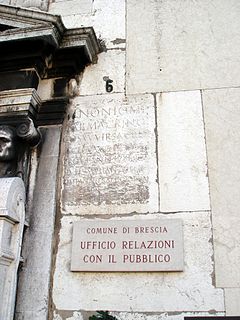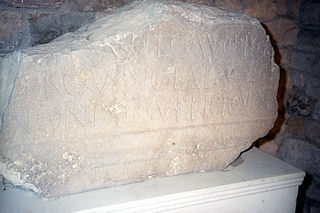Related Research Articles

Pannonia Inferior, lit. Lower Pannonia, was a province of the Roman Empire. Its capital was Sirmium. It was one of the border provinces on the Danube. It was formed in the year 103 AD by Emperor Trajan who divided the former province of Pannonia into two parts: Pannonia Superior and Pannonia Inferior. The province included parts of present-day states of Hungary, Serbia, Croatia, and Bosnia and Herzegovina. The province was bordered to the east by a Sarmatian tribe—the Iazyges. Later, the Vandals appeared to the north-east.

Marcus Nonius Macrinus was a Roman senator and general during the reigns of the Emperors Antoninus Pius, Lucius Verus, and Marcus Aurelius. Macrinus was suffect consul in the nundinium of April-June 154 as the colleague of [Prifernius ?] Paetus.
Titus Pomponius Proculus Vitrasius Pollio was a Roman senator, who held several imperial appointments during the reign of Marcus Aurelius. He was suffect consul in an undetermined nundinium around 151; he was a consul ordinarius in the year 176 with Marcus Flavius Aper as his colleague.
Titus Statilius Maximus was a Roman senator of the 2nd century AD. He was consul in the year 144 as the colleague of Lucius Hedius Rufus Lollianus Avitus. He is known entirely from inscriptions.
Servius Cornelius Scipio Salvidienus Orfitus was the name of several Roman men who lived during the early Roman Empire. They were descendants of Orfitus who was adopted by Servius Cornelius Scipio, an otherwise unknown member of the patrician branch of the Cornelii Scipiones.
The gens Cominia was a minor plebeian family at ancient Rome, which appears in history from the Republic to imperial times. The first of this gens to hold the consulship was Postumus Cominius Auruncus in 501 BC, and from this some scholars have inferred that the Cominii were originally patrician; but all of the later Cominii known to history were plebeians.
Lucius Hedius Rufus Lollianus Avitus was a Roman senator and military officer. He was consul in the year 144 as the colleague of Titus Statilius Maximus.
Sextus Julius Major was a Roman senator active during the first half of the second century, and who held several positions in the service of the emperor. Major was suffect consul around 126. Major's origins were with the "high aristocracy" of Asia Minor. Ronald Syme notes his ancestors included Polemon I the king of Pontus and Antonia Pythodoris.
Marcus Metilius Aquillius Regulus was a Roman senator of the second century. A member of the patrician order, he held the office of consul ordinarius in 157 with another patrician, Marcus Vettulenus Civica Barbarus, as his colleague.
Marcus Vettulenus Civica Barbarus was a Roman senator of the second century. A member of the Patrician class, he held the office of consul ordinarius in 157 with another patrician, Marcus Metilius Aquillius Regulus, as his colleague. Barbarus was also a member of the sodales Antoniniani, a religious fraternity which attended to the cult of the emperor Antoninus Pius.
Lucius Dasumius Tullius Tuscus was a Roman senator who was an amici or trusted advisor of the emperors Antoninus Pius and Marcus Aurelius. He was suffect consul in the nundinium of April to June 152 as the colleague of Publius Sufenas.
Marcus Peducaeus Stloga Priscinus was a Roman senator active during the middle of the second century AD. He was ordinary consul for 141 as the colleague of Titus Hoenius Severus. An inscription from the Great Theatre at Ephesus mentions a Marcus Peducaeus Priscinus as proconsular governor of Asia in 155/156, whom professor Géza Alföldy, amongst others, has identified as this Priscinus. Priscinus is known only through surviving inscriptions.
Marcus Pontius Laelianus Larcius Sabinus was a Roman senator and general who held a series of offices in the emperor's service. He was suffect consul for the nundinium of July-August 145 as the colleague of Quintus Mustius Priscus. Laelianus is primarily known through inscriptions.
Quintus Fuficius Cornutus was a Roman senator active in the first half of the second century AD, who held a number of offices in the emperor's service. He was suffect consul for the nundinium April-June AD 147 with Aulus Claudius Charax as his colleague. Cornutus is known only from inscriptions.

Marcus Iallius or Jallius Bassus was a Roman senator, general, and literary figure who held several offices in the imperial service during the mid-second century AD. He was suffect consul around the year 159. Bassus is known primarily from inscriptions. His full name was Marcus Iallius Bassus Fabius Valerianus.
Gaius Prastina Messalinus was a Roman senator, active during the reign of Antoninus Pius. He was consul in the year 147 with Lucius Annius Largus as his colleague. Messalinus is known entirely from inscriptions.
Titus Flavius Boethus was a Roman senator, who was active during the reign of Marcus Aurelius. He is known as being an acquaintance of the physician Galen. Boethus was suffect consul in one of the nundinia falling in the later half of 161 with [? Julius] Geminus Capellianus as his colleague.
Publius Cluvius Maximus Paullinus was a Roman senator, who held a number of imperial appointments during the reigns of Hadrian and Antoninus Pius. He was suffect consul during an undetermined nundinium between 139 and 143. He is known entirely from inscriptions.
Titus Statilius Maximus Severus Hadrianus was a Roman senator, who was active during the reign of Trajan. He was suffect consul in the year 115, replacing the consul Marcus Pedo Vergilianus killed by an earthquake in Antioch.
Marcus Servilius Fabianus Maximus was a Roman senator, who was active during the reigns of Antoninus Pius and Marcus Aurelius. He was suffect consul in a nundinium in mid-158 with Quintus Jallius Bassus as his colleague.
References
- ↑ Werner Eck, "Die Fasti consulares der Regungszeit des Antoninus Pius, eine Bestandsaufnahme seit Géza Alföldys Konsulat und Senatorenstand" in Studia epigraphica in memoriam Géza Alföldy, hg. W. Eck, B. Feher, and P. Kovács (Bonn, 2013), p. 76
- ↑ Syme, "Governors of Pannonia Inferior", Historia: Zeitschrift für Alte Geschichte , 14 (1965), p. 360
- ↑ Géza Alföldy, Konsulat und Senatorenstand unter den Antoninen, (Bonn: Habelt Verlag, 1977), p. 299
- ↑ Alföldy, Konsulat und Senatorenstand, p. 230
| Political offices | ||
|---|---|---|
| Preceded by Sextus Quintilius Condianus, and Sextus Quintilius Valerius Maximus, then unknown as ordinary consuls | Suffect consul of the Roman Empire 151 with Lucius Attidius Cornelianus | Succeeded by Gaius Curtius Justus, and Publius Julius Nauto as suffect consuls |